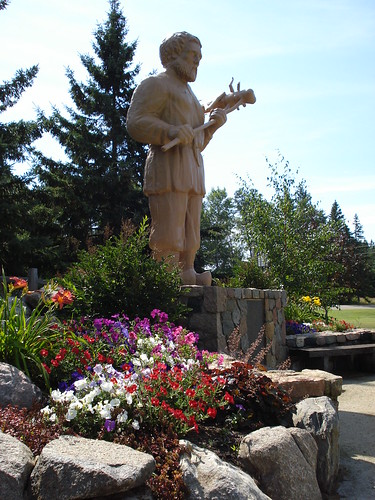
This one is kind of strange and, for this blog, that's really saying something.
The legend of St. Urho goes that a long time ago in Finland the grape crop was being destroyed by grasshoppers. Urho drove away the grasshoppers using his booming voice by chanting "Heinäsirkka, heinäsirkka, mene täältä hiiteen!", which translates to "Grasshopper, grasshopper, go from hence to Hell!"
St. Urho's day is celebrated on March 16th by wearing royal purple and Nile green, drinking beer (even green and purple beer) and wine, and feasting on mojakka, which is basically just soup. The plaque below this St. Urho statue even describes a celebration where Finnish women and children gather around the shores of the many lakes in Finland and chant what St. Urho chanted. All the while, the men dress in green costumes and gather on the hills overlooking the lakes and, basically, act like grasshoppers and slowly disappear to change into purple costumes. Then the polka and drinking begins.
Now this is where it gets weird.
"What", you say, "that wasn't weird already?"

The legend of St. Urho can be traced as far back as the 1950's to a region known as Northern Minnesota. It seems most of those familiar with the legend credit Richard Mattson of Virginia, MN as the creator. It was in 1953 while working at Ketola's department store in Virginia when Mattson first spun his tale. He was being teased by his Irish co-workers that the Finns didn't have any great saints like St. Patrick, so Mattson made up a story about a St. Urho. The women of the store threw a party in the coffee room and Gene McCavic wrote a poem for St. Urho. And thus the legend began.
In 1956, the media got a hold of it. The local paper, the Mesabi Daily News, wrote about it and in the years since St. Urho has been featured in newspapers around the country.
The legend and holiday we know today is a little different than Richard Mattson originally told it. First of all, the celebration was originally supposed to be in May, but Finns wanted to move it to rival St. Patrick's day and get a head start on the green beer (no doubt the next day they will suddenly be Irish like most of the country). More notably, Mattson's original tale told of how Urho used his powerful voice, which he obtained by drinking "feelia sour" (sour whole milk) and "kala mojakka" (fish soup), to cast out poisonous frogs from Finland. Somehow Dr. Sulo Havumäki, a psychology professor at Bemidji State College (now Bemidji State University) had influence over the legend and the story changed to grasshoppers. Some even credit Havumäki as the creator of the legend. His name is on the plaque below the St. Urho statue.
Richard Mattson passed away in 2001, but his legend of St. Urho lives on. St. Urho's Day is celebrated in a number of Minnesota towns, including Finland, MN (they have an Urho sculpture too), and in Finnish towns across the country, like Butte, MT and Hood River, OR and several others. The legend has even spread into Canada and reached all the way back to Finland, where you can find more than one St. Urho's Pub.
In 1975, the city of Menahga commissioned a Minneapolis sculptor to carve a statue of Urho out of a 1-ton block of oak, but they got swindled. Dude must have been a contractor. In 1982, a traveling chainsaw sculptor named Jerry Ward took the block and created a 12-foot tall sculpture of St. Urho holding a pitch fork with a giant grasshopper speared on the end of it. That carving took a beating from the weather and termites and was replaced by the current fiberglass recreation. The old wood carved statue was moved to a mausoleum in a local cemetery.
For more info:
SaintUrho.com
St. Urho on Wikipedia
Roadside America


1 comment:
I grew up close to Menahga, and the story was presented to me as legitimate as the St Patrick's story. Ha! Now, 25 years later, I find out it was invented by some guy on the Iron Range.
Post a Comment